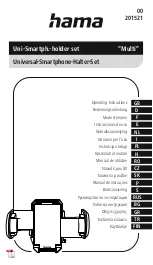
Quick Start Guide for GPS160USB V1.00
TEL + 44 1179 554474 www.digitalyacht.co.uk
3. Installation
Before starting installation select a suitable location for the GPS160USB Receiver. The unit features a very sensitive
GNSS receiver and in many boats the GPS160USB will operate quite happily below deck or in a wheel house. If you find
that you are getting good performance with the GPS160USB mounted below deck, then installation is simple and you just
need to find a suitable location where the GPS160USB can be firmly fixed.
For absolute optimum performance, then on-deck mounting is recommended and the unit is fully water proof and
designed for permanent mounting outside. The GPS160USB
antenna has the popular 1” x 14 TPI thread mount, found in
many VHF antennas. A wide variety of different brackets are available for this type of threaded mount, consult your local
marine electronics dealer or chandlery for more information.
The 1” x 14 TPI thread mount can also be removed by unscrewing the three hex bolts with a suitable Allen Key, allowing
the GPS160USB to be flush mounted on a flat horizontal surface. A mounting kit (as shown in the diagram below) is
available from Digital Yacht (Part# X500.400). In this situation, a bead of silicone sealant should be applied around the
antenna, after mounting it, to avoid standing water accumulating under the antenna.
Dimensions;
The GPS160USB is supplied with 5m of USB cable and this should be routed through the vessel to a suitable dry internal
location where it can be connected to the Windows/Mac/LINUX PC which will provide power to the GPS160USB and
receive the GNSS data from the GPS160USB.
The GPS160USB has a number of operating modes that can be set by adjusting four DIP switches inside the unit.
Section 4 of this manual explains how to select the different modes. By default the GPS160USB will output;
-
GLL, GGA, RMC, VLW, VTG and ZDA once per second at 4800 baud (TriNav
™
Mode)
This default mode is good for most applications and uses all of the available satellites from the GPS, GLONASS and
GALILEO constellations.
Содержание TriNav GPS160USB
Страница 1: ...GPS160USB POSITIONING SENSOR...

























